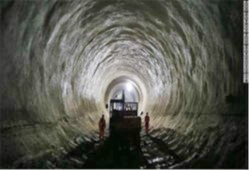
Set to open in 2018, the Crossrail expansion of London’s rail network is the largest civil engineering project in Europe. Once complete, 56 kilometers (35 miles) of new tunnels, stations, and interchanges will connect the outer suburbs to the city center and Heathrow Airport, nearly 40 meters (131 feet) below the city. It is a huge feat of engineering with a budget of more than $20 billion. CH2M has worked on more than 20 projects involving Crossrail, including program management.
For those involved, the biggest challenge has come from working in a densely packed city such as London, steeped in 1,000 years of industrial history. “It’s not just buildings or the underground, but utilities corridors. It has been the biggest challenge of my career,” project manager Linda Miller told CNN.
At Farringdon station in central London, those working on the project refer to it as “the heart of the Crossrail.” Of the eight tunnel boring machines that set off from different parts of the city, four of them ended up in Farringdon. “Sometimes in this job it feels like you have landed on the moon; it’s so unrecognizable,” explains Miller, “(but) it’s going to move from looking like the moon to a transportation system.”
Work on the Crossrail began 6 years ago, with a team working 24 hours a day beneath the city. But even a millimeter of movement in the soil can cause problems for buildings above the ground. Engineers need to compensate for this by pumping grout through pipes to stabilize buildings on the surface. The vast amounts of material removed to make way for the tunnels is being used to create a 1,500-acre nature reserve in Essex.
The project is also a challenge for those managing it. “Anytime you have a big project like this, it’s all about how you divide it up and put it into manageable bits” explains Bill Tucker, central section delivery director, who manages 650 staff and 22 contractors. Tucker likens the skill involved to that of a conductor in an orchestra. “I’m up there with the sheet music, making sure everybody is on the same note, at the same bar and the same tempo.”
